Is your tiny apartment now too cramped for your plants and animals?
It might be time for you to take the next step in your journey to self-sufficiency: moving to a place where the laws are friendly, water is abundant, the weather is great, the land is fertile, and the community is supportive.
So where the heck can you find a place like that?
In this article, we’ll tell you which factors to keep in mind. Plus, keep an eye out for our list of the 10 best places to live off the grid based on these components.
The 7 Factors to Choosing the Best Place to Live Off the Grid
The ideal place for living off the grid depends on your priorities and preferences, but there are 7 general factors to consider:
Climate
It’ll be devastating to lose your crops and animals to severe weather conditions, so pick a place with a climate you can handle. Know the types of natural disasters common to the area, too.
You should also study the USDA hardiness zone maps if you want a good harvest. Think of these as cheat sheets that tell you what crops are the most suitable to plant with your climate.
Cost of Land
One state’s cost per acre may be cheap, but consider the region’s average farm size. If the average farm size is big, expect to pay more than you thought you would.
Quality of Land
This matters even more than the cost of land. If you had to pick between cheap land or quality soil, it’s clear what your choice would be. Fertile soil is necessary if you want to have enough veggies to feed your household and to sell to others.
State Laws
Some states offer more leeway in raising animals and growing and selling food. Find out whether the state is open range or fence in, if you can bring in livestock from a different state, or if you need a license to sell specific types of food.
Water Availability
Obviously, your property should be near rivers or lakes or at least receive enough rain every year. But that’s not everything you need to research if your goal is to be living off the grid. It’s smart to look up water and rain harvesting laws, too.
While collecting rain isn’t illegal, certain states regulate how much rain you can collect and how you collect it. In Colorado, for example, folks can gather rainwater in two rain barrels with a capacity of 110 gallons combined. They can only use the water on their property and just for outdoor purposes.
Also, know how you can get water rights. These are usually sold with a property, so if you can find a place with these rights, that will be great.
Even when you have a river right next to your property, remember it belongs to the public. Secure water rights or at least know what the law allows to avoid landing in any trouble.
Education
If you have kids, education is another thing to consider. Many folks living off the grid choose to homeschool since the nearest school is miles away. This can be your reality when you move, so read up on homeschooling laws before you make any big decisions.
The Community
Proximity to schools, groceries, and other stores won’t matter if you want to be as far away from civilization as possible. But if you want a tight-knit community, the best places to live off the grid are areas where similar-minded people reside.
Consider your personal beliefs as well. Will you get along fine with folks who may not share your values, or will it be an issue?
The Best Places to Live Off the Grid
Before we reveal which states made the cut, we want to point out that there’s no such thing as the best state to live off grid. Some areas can have the best weather but fall short on safety, while others can have low crime rates but are prone to natural disasters.
The lineup you’re about to see is a list of the 10 best places to live off the grid in America. Using the 7 factors as a guide, we scoured through countless stats, forums, and blogs and came up with the following states:
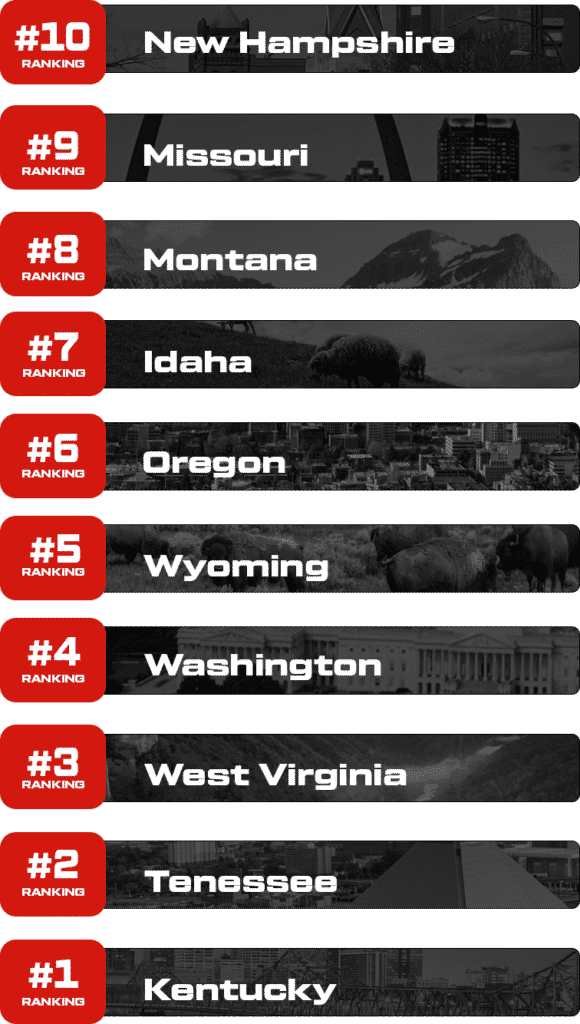
10. New Hampshire
As one of the country’s original 13 colonies, New Hampshire is a state with a lot of old-school appeal. You’ll find several historical landmarks dotted throughout the region, with centuries’ worth of heritage waiting for you to discover.
But that’s not everything to love about the Granite State. If you’re seeking a connection with nature, a place that isn’t crowded with people, or acres of land for growing crops, you’ll find all that here.
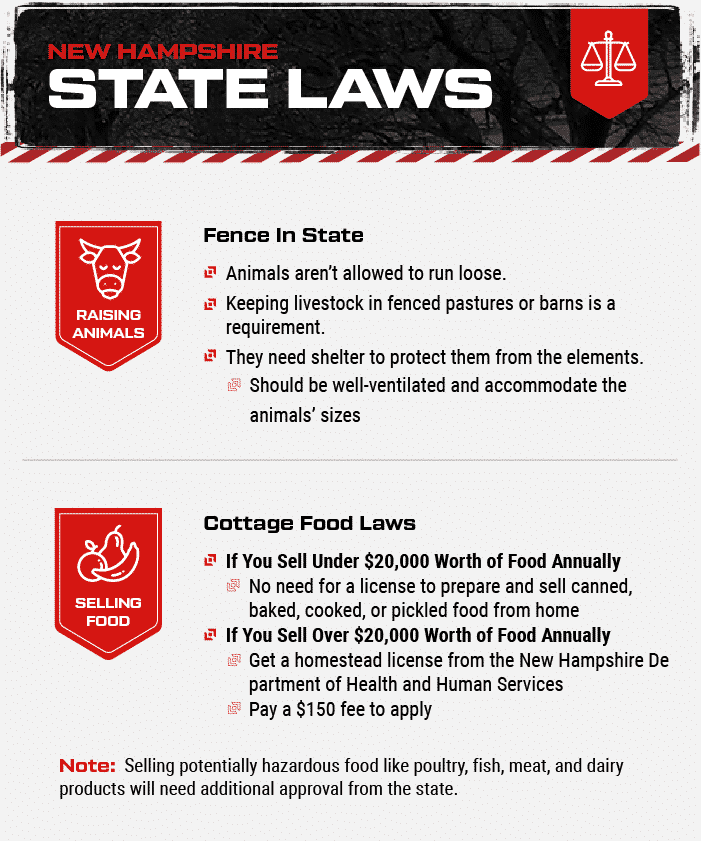
Climate
New Hampshire has all 4 seasons and an average growing season of 149 days. Since its winters are long, it’s a good idea to build a greenhouse if you don’t want to do a lot of canning before the cold starts creeping in.
The state belongs under USDA zones 3 to 6, meaning these crops will do well:
- Apples
- Sweet corn
- Cucumbers
- Asparagus
- Turnips
Cost of Land
You’ll find farms of all sizes in New Hampshire. Some are family-run, while others belong to huge corporations. Currently, the state’s average price of farm real estate is $5,050 per acre.
Quality of Land
As a whole, the soil here is acidic. But found in the hillsides and uplands is the Marlow — the New Hampshire state soil. Marlow soils are well-drained and are crucial to the state’s agricultural industry.
Before you start planting anything, get your soil tested. If it’s above the normal pH levels, you can neutralize it by adding limestone, compost, or wood ash.
Water Availability
The state gets an average of 46 inches of rain and 68 inches of snow per year. It also has nearly 1,000 ponds and lakes. Majority, or 54% of households in New Hampshire, rely on public water systems for drinking water. The remaining 46% get their supply from private wells.
As several cities depend on surface waters, the Natural Resources Conservation Service (NRCS) is working hard to help private landowners with best management practices. These practices help improve your soil health, giving you higher-quality crops. Plus, they help decrease nutrient runoff, so other New Hampshire residents can enjoy safe drinking water.
Education
To homeschool your kid in New Hampshire, you’ll need to:
- Give the school principal a letter of intent to homeschool within 5 business days of homeschooling your child
- Teach the required subjects (ex. mathematics, language arts, science, history, government, etc.)
- Maintain records of work samples
- Have your kid evaluated each year
Also, take note that kids between the ages of 6-18 are required to receive instruction.
The Community
If you want to say goodbye to the big city, you won’t regret heading over to New Hampshire. It’s a small state that’s heavy on outdoor beauty — we’re talking thick forests, clear lakes, and alpine mountains. Sounds like a breath of fresh air, huh? That’s why it’s one of the best places to live off the grid.
Besides being a happy place for both nature lovers and adrenaline junkies, New Hampshire also has a low crime rate (well below the nation’s average). Needless to say, it’s a safe place to raise your kids and live out the self-reliant lifestyle you’ve wanted for so long.
9. Missouri
Most folks associate Missouri with Mark Twain, St. Louis, and the Gateway Arch. But the Show Me State is also full of rural farmland, making it a good choice for people who want to grow crops or raise animals.
Interested in making Missouri your new home base? Here’s a guide to help you out:
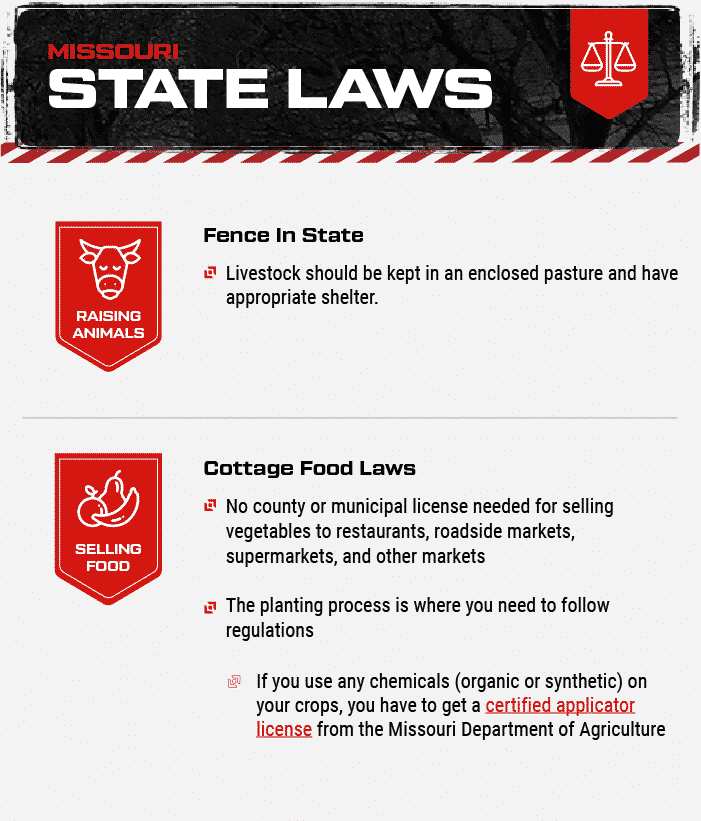
Climate
Missouri is a pretty humid state. Its average temperature in the summer is 80° Fahrenheit, while winters can get as cold as 29° Fahrenheit.
The state is in hardiness zones 5b to 7, perfect for cool-season plants. It’s best to plant the following in Missouri:
- Brussels sprouts
- Cabbage
- Beets
- Potatoes
- Watermelons
- Grapes
- Apples
Cost of Land
In 2021, the average price of farm real estate per acre was $3,700. Meanwhile, the average costs for cropland and pasture land were $3,810 and $2,160, respectively. The average farm size as of 2017 is 291 acres.
Quality of Land
Missouri’s north and northeast regions have Kickapoo and Dockery soils. Since these soils are heavy, they don’t take well to overwatering. The state also has Leonard, Sampsel, Gerald, and Putnam soils.
These aren’t the most reliable soils, but Missouri does have Menfro soil — its state soil. Located beside the Missouri and Mississippi rivers, Menfro is well-drained and perfect for soybeans and corn, aka the state’s main crops.
Water Availability
The state enjoys an annual average rainfall of 40 inches, and it doesn’t have any regulations barring rainwater collection. Plus, it’s blessed with streams, rivers, and lakes that stretch out thousands of miles. Because of this, you won’t find it difficult to find, get, and gather H2O.
Education
It’s easy to homeschool your kid in this state; just follow these steps:
- Withdraw your kid from the school they’re currently enrolled in (if they’re enrolled, so you can avoid truancy problems).
- Maintain samples of their work, periodic assessments, and hours of instruction.
- Provide 1,000 hours of instruction every school year.
- 600 hours should go to core subjects like reading, language arts, math, science, and social studies.
- 400 of the 600 hours must be provided at home.
The Community
Missouri is known as a flyover state, and those types of states make the best places to live off the grid.
Currently, 6.12 million folks inhabit the state, but most of them stay in the 5 major cities. While Missouri’s crime rate may be a little higher than the national rate, if you stick to living in the less populated areas with lower crime rates up north, you’ll be fine.
This is another state that appeals to outdoorsy types. If you love swimming or catching fish, there are several waterways you can visit.
One more thing to know? Many Missourians love their Second Amendment rights. Don’t be shocked to see random firearms when you’re going for a walk outside or shopping for groceries.
8. Montana
Montana is hands down one of the most breathtaking states in the country. Have you SEEN the Rocky Mountains? The state is also known for its two national parks, Glacier and Yellowstone.
But that’s not everything to love about living in Big Sky Country. It’s a practical choice for those who want to try off grid living as well.
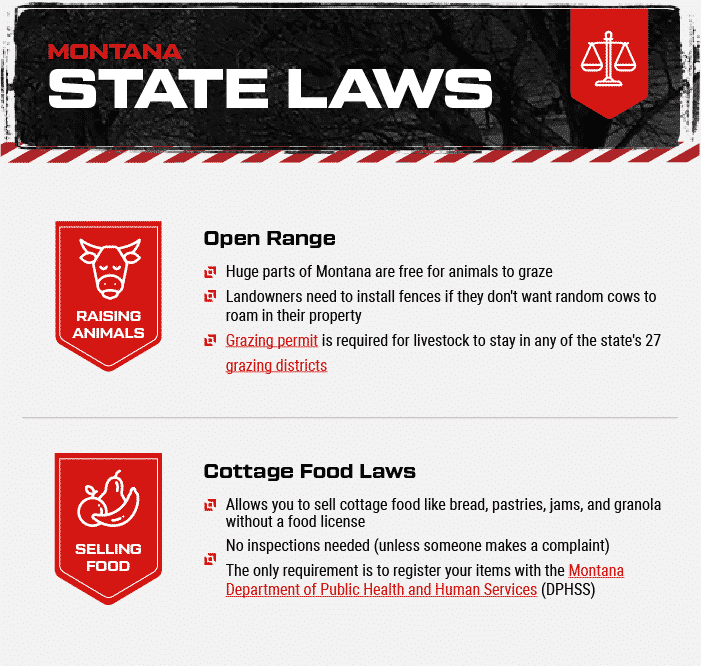
Climate
Montana has an average annual growing season of 116 days. It experiences long and harsh winters, so factor that in when you choose what produce to grow and when to grow them.
Since Montana encompasses USDA hardiness zones 3, 4, 5, and 6, you can plant the following:
- Beets
- Carrots
- Potatoes
- Tomatoes
- Beans
Cost of Land
The land in Montana is quite cheap. Most ranches and farms are actually family-owned. But since the average size of a homestead or farm is 2,314 acres here, you might find it challenging to find a tinier piece of land for sale.
As of 2021, the average price per acre of farm real estate (land and buildings) is $930 according to the USDA. Cropland is $1,050 per acre while pastureland is $700 per acre.
Quality of Land
Montana is the second top producer of honey in the country and is also one of the top wheat growers. So, don’t worry. With its soil, you’ll be able to harvest a bunch of crops.
Water Availability
Montana is one of 3 states considered the most vulnerable to drought, according to the National Oceanic and Atmospheric Administration, thanks to its dependence on agriculture and cattle ranching.
So it goes without saying: stockpile plenty of water to keep your off grid homestead afoot. The state has no laws against rainwater harvesting, so get those rain barrels out when you see the clouds looking heavy.
You can also find water rights by looking them up online. Search them by basin code and WRN number, by Geocode, or by owner. Read more about the subject here.
Education
If you homeschool your kid, you can choose any curriculum or materials for the subjects. Just take note of these requirements:
- File a notice of your intent to homeschool with the county superintendent every school fiscal year (July 1 – June 30).
- Maintain attendance and immunization records (or a medical or religious exemption).
- Teach the specified hours of instruction each year (720 hours for grades 1-3 and 1080 hours for grades 4-12).
- Include the required subjects of math, social studies, science, language arts, health, arts, and career education.
- Teach in a location that’s safe and complies with local health regulations.
The Community
Montana is a paradise for outdoor lovers. You’ll fit right in if you enjoy activities like hunting and fishing. But if you’re against weapons, good luck. Many folks carry guns and knives out in public.
Montana is also one of the least populated states in the country, despite being the fourth largest in size. An estimated 1,068,778 people call the state home.
7. Idaho
Idaho has become home to many homesteaders because of its rich, fertile soil and friendly homestead laws. It also doesn’t hurt that the state has spectacular views.
But because Idaho is one of the best states for off grid living, expect land prices to go up. Don’t be surprised about having more neighbors, too.
Here’s what you should know about homesteading in Idaho:
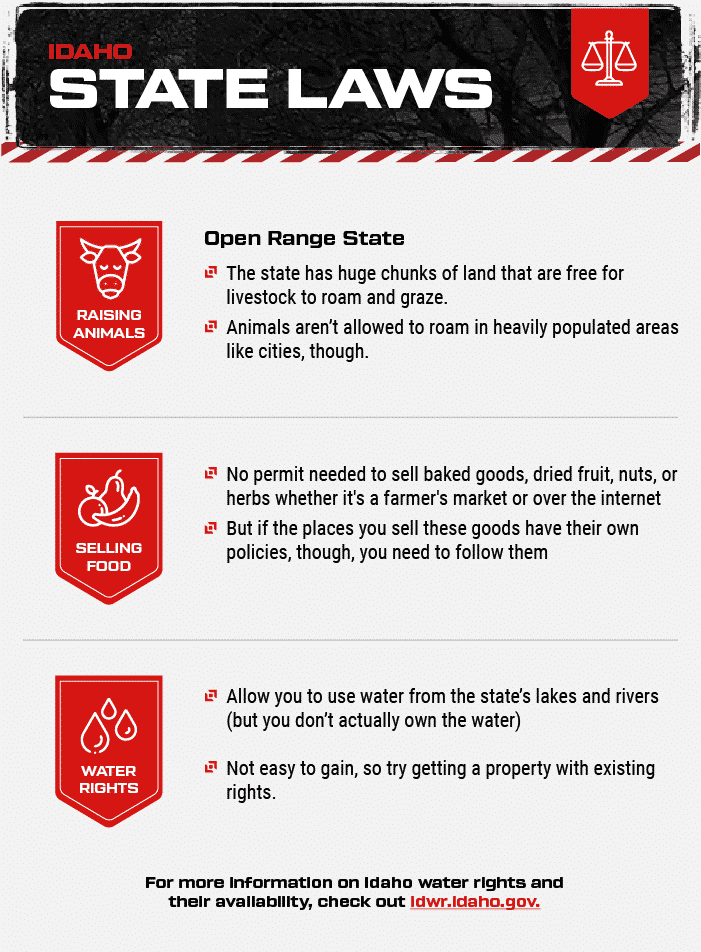
Climate
Depending on which part of Idaho you settle in, you can experience hot summer days, cold but dry winters, and low humidity.
Also, since Idaho is a southwestern state, it does have instances of drought. But the main disasters the state experiences are fires and floods.
Wildfires are particularly common, with the state experiencing 21 wildfires in August 2021 alone. As of 2019, Idaho has the distinction of being second only to Montana as the state with the highest percentage of homes at a high to extreme risk of wildfires.
The state is in USDA plant hardiness zones 3 to 7. Here are plants you can plant there:
- Potatoes
- Broccoli
- Cabbage
- Carrots
- Squash
- Tomatoes
Cost of Land
Currently, Idaho’s average price for farm real estate is $3,350 per acre. In contrast, it has an average price of $1,700 per acre for pastureland and $4,450 per acre for cropland.
Quality of Land
Idaho is pretty diverse when we talk about soil. Since precipitation in the state can be anywhere from 8 to 60 inches per year, its soil has varying mineral content and pH levels.
Here’s more info on the type of soils in Idaho:
- Common soils in Idaho great for agriculture
- Mollisol
- Entisol
- Inceptisol
- Soils in the southern regions
- Aridisol
- Soils in the northern regions
- Andisols
- Soil in the Idaho forests
- Alfisols
Water Availability
Idaho is mostly dependent on groundwater to supply its residents with drinking water. If there isn’t enough groundwater, then the state has to resort to using water from streams, reservoirs, and rivers.
As Idaho is susceptible to droughts, you’ve got to be mindful about water usage.
Consider planting drought-tolerant veggies like corn, beans, and sweet potatoes. You can also recycle graywater (water from showers, bathtubs, and laundry) for irrigating your lawn. Just don’t use it on your veggies!
Education
Idaho is homeschool-friendly. Based on the state’s home education laws, there’s no specific amount of time required for parents to teach their kids. They don’t need to worry about having attendance records as well.
But there are still guidelines to follow, like:
- Start homeschooling your kid by the time they’re 7 years old
- Set a schedule for your kid’s instruction
- Teach your kid the typical subjects students learn in school (ex. math, science, language arts, social studies)
Also, the state mandates that kids between 7 and 16 should receive either formal schooling or a similar education at home. So your kid can’t graduate from homeschool if they’re below 16.
Check out this article for more information about homeschooling in Idaho.
The Community
Outdoor enthusiasts love Idaho. Since it’s surrounded by rivers, mountains, forests, and hillsides, outdoor activities are basically a given.
The people are also friendly and welcoming. Expect to find many folks who share your self-sufficient way of life.
Overall, it’s one of the best places to live off the grid if safety is a top priority for you. It has one of the lowest crime rates in the country.
Idaho is also gun-friendly. Any Idaho resident 18 and above can carry firearms without a permit. Depending on your beliefs, this can be good news or bad.
6. Oregon
There are plenty of natural attractions to see in Oregon. The state boasts beautiful beaches, forests, and deserts that nature lovers are sure to love.
Although the cost of living in Oregon is higher than in some states, its farmland value is still pretty much affordable. More important is that Oregon has a solid homesteading community and about 30,000 small farms spread across the state.
If you want to be part of that community, read on:
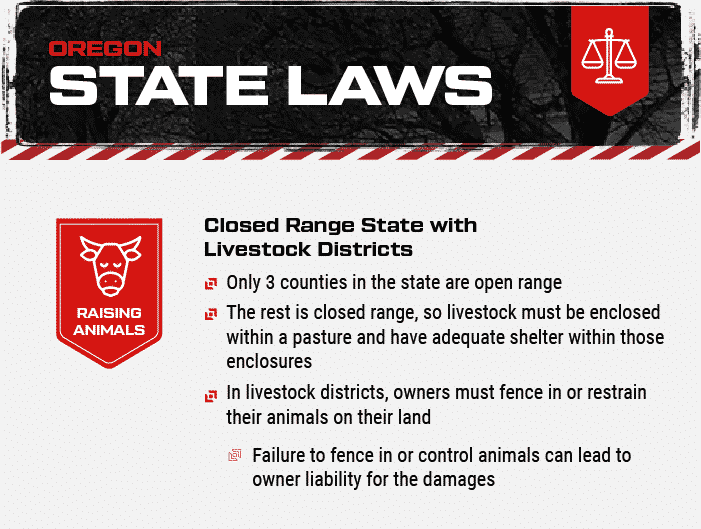
Climate
For most of the year, Oregon receives humid ocean currents. In the summer, particularly in July and August, the weather improves because of the subtropical high-pressure system of the Pacific.
In short, Oregon is a sunny state in the summer, when the North Pacific High prevails. For the rest of the year, the sky is cloudy during the frequent periods in which low-pressure systems dominate, but the sun still makes an appearance every now and then.
Cost of Land
There are thousands of properties and rural land for sale in Oregon. When combined, they represent 903,834 acres of land. The average price of farms, ranches, and other land parcels in the states is $765,618.
Quality of Land
The valley floor of the Willamette River Basin is where you will find the most fertile soils and experience a long growing season. It’s one of the most important agricultural areas in Oregon. Some products grown in the valley include:
- Horticultural plants
- Vegetables and fruits
- Grass seed
- Wine grapes
- Christmas trees
- Grain
- Hay
Even with Oregon’s diverse landscape, growing your food won’t be a problem because the official state soil, the Jory soil, is found in 9 western Oregon counties on over 300,000 acres. Its deep, well-drained, rich, and red characteristics can produce a wide variety of crops, orchards, and vineyards. It also has high productivity properties.
Water Availability
The Oregon water law states that all water belongs to the public. However, cities, irrigators, businesses, and other water users are required to obtain a permit or license from the Water Resources Department to use surface and groundwater, given that it’s to be used for a beneficial purpose without waste.
Also, landowners with water flowing past, through, or under their property don’t automatically have the right to use that water unless they have authorization from the Water Resources Department.
Education
If you desire to homeschool your children in Oregon, do the following:
- Notify the local Education Service District (ESD) of intent to homeschool within 10 days of withdrawing from public or private school.
- Coordinate with Homeschool Tester(s) to assess student growth at the end of grade levels 3, 5, 8, and 10.
- Submit test results to local ESD when requested.
The Community
Considering Oregon is one of the most desired states to move to, there’s no reason for you not to check it out. It offers diverse natural scenery, an expansive coastline, and so much more.
Oregon also has a massive community of homesteaders. Many homesteaders enjoy having neighbors or a nearby town to share resources with and build friendships. Plus, the people are easy-going and hospitable, and the state typically has a laidback culture.
5. Wyoming
Wanna kick sustainable and off grid living up a notch? Wyoming has plenty to offer, from small communities to vast and open landscapes. With its more than 30 million acres of farmland and abundant natural resources, farming and livestock rearing have been a way of life for Wyomingites.
Here’s why Wyoming is one of the best states for off grid living:
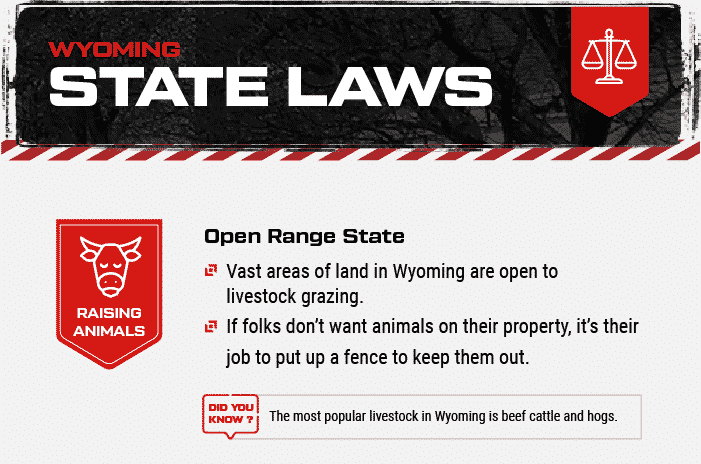
Climate
Wyoming has a semi-arid type of climate with warm summers and cold winters.
In the summer, temperatures can rise to 90 degrees Fahrenheit in the plains, while temperatures can rise to 75 degrees Fahrenheit in the highlands.
Winters in Wyoming are freezing, and temperatures can dip as low as 18 degrees Fahrenheit across different areas and elevations in the state.
Cost of Land
If you’re looking for a bargain, Wyoming has some of the cheapest dollar-per-acre land values in both pasture and cropland compared to other surrounding states. As of 2021, the cost of farm real estate per acre in Wyoming is $790.
Quality of Land
Wyoming’s soils don’t contain much organic matter but don’t let this discourage you.
You can constantly improve the organic matter in soil on a small scale by incorporating a 1 or 2-inch layer of organic material into your gardens like compost, lawn clippings, and manure.
Some great edible crops grown in Wyoming include:
- Cabbage
- Green beans
- Beets
- Carrots
- Radishes
- Potatoes
Water Availability
Groundwater is an important water source in Wyoming. Wyoming is estimated to have about 10 million acre-feet of water stored in alluvial aquifers and around 3 billion acre-feet in bedrock aquifers.
About 25% of municipal water users in the state rely on groundwater, 45% rely on both ground and surface water, and an unspecified number of rural residents rely on private groundwater sources.
Wyoming contains five river basins. The four open river basins include the following:
- Missouri-Mississippi
- Green-Colorado
- Snake-Columbia
- Great Salt Lake
Education
In Wyoming, homeschooling is defined as a program of educational instruction provided to a child by the child’s parent or legal guardian or by a person designated by the parent or legal guardian.
A program must meet the requirements of a Basic Academic Educational Program, which is defined as a program providing a sequentially progressive curriculum of fundamental instruction in 7 subjects:
- Reading
- Writing
- Mathematics
- Civics
- History
- Literature
- Science
A home-based educational program must also meet the following requirements:
- Provide a letter of intent or complete the district homeschool registration form
- Submit curriculum to the local district each year
- Provide a summary of your curriculum to your local school district office
- The curriculum must include reading, writing, literature, math, science, history, and civics
- Failure to submit the curriculum is evidence that the home-based educational program does not meet the requirements.
The Community
Wyoming isn’t just one of the best places to live off the grid; it’s also one of the friendliest states in the country. According to a survey from RTA Outdoor Living, Wyomingites are the 2nd most friendly neighbors in America.
4. Washington
Of course, we couldn’t leave out the Evergreen State from our list of best places to live off the grid. With its fertile land, rows of mountains, and Pacific coastline, Washington makes an idyllic setting for off grid living.
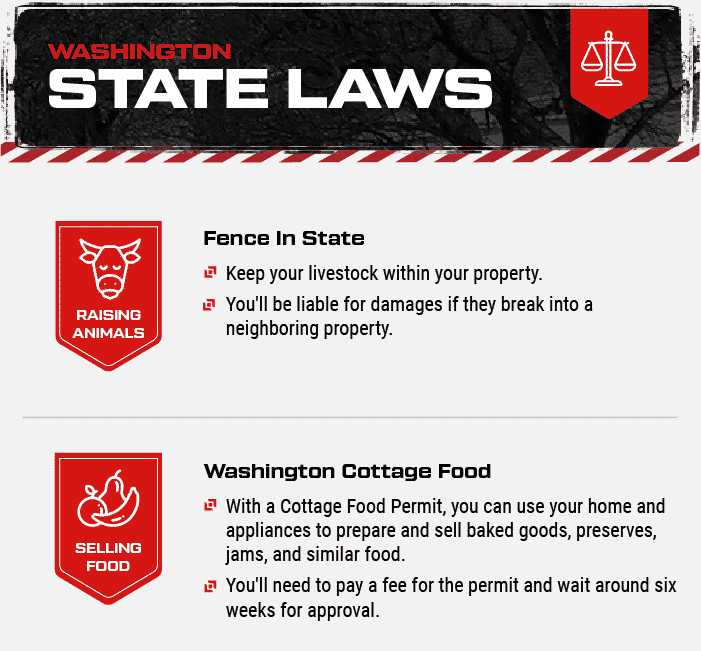
Climate
Folks who don’t live in Washington are under the impression that it rains there all the time. The reality? It rains more in cities like New York and Miami every year than it does in Seattle.
As a whole, Washington doesn’t really get hit by natural disasters. You won’t have to worry about hurricanes and tornadoes because the state is geographically diverse. Blizzards and major floods are also rare.
The state falls under USDA plant zones 4 through 9. Some of the crops that thrive in its climate include:
- Asparagus
- Radishes
- Rhubarb
- Cabbage
- Onions
- Apples
Cost of Land
The state’s average price of farm real estate is $2,900 per acre as of 2021. On the other hand, the average cost of pasture land per acre is $750 while $2,700 is the average price of cropland per acre.
Quality of Land
Agriculture is essential to Washington’s economy.
Case in point: it’s the top apple grower in the country. The state is responsible for 70% of the fruit’s total production, which is valued at around $2.095 billion dollars.
Besides apples, Washington’s farmers are also responsible for producing more than 300 types of crops. That’s proof that there’s something good in the soil over there.
Water Availability
How much rain you’ll get depends on which part of the state you’re in. If you’re staying in Western Washington (the most densely populated area in the state), you’ll get approximately 37 inches of rainfall every year.
Eastern Washington doesn’t receive as much rain since the Cascade Mountain Range catches most of it. This region gets about 15 to 30 inches of rainfall annually.
While you don’t need a permit to collect rainwater, you may only use it for your property. There are also other rules you should know. You can visit this page for further details on Washington’s water availability.
Education
Washington State gives you two choices for homeschooling your kid legally — home-based instruction and a private school extension program.
Both have specific requirements you have to follow:
Under the Home-Based Instruction Law
- Be qualified to homeschool. There are four ways:
- You have 45 quarter units of college-level credit.
- Be approved as a home-based instructor by the local school superintendent.
- You’re willing to meet a state-certified teacher every week for at least an hour.
- Finish the state’s homeschool parent qualifying course.
- Submit your notice of intent to homeschool.
- Teach the required subjects.
- Let your kid take one of the state’s annual assessments
- Teach at least 180 days or 1,000 hours a year.
- Maintain records.
Under a Private School Extension Program
- Enroll your kid in an approved private school that has an extension program.
- Meet the school’s extension program requirements.
The Community
Check the United States map, and you’ll find Washington State way, way up there. So if you want to live away from the masses, head over to this region in the northwest. It’s far enough from people but not too removed that you can’t stay updated on current events.
Washington is a fantastic state for off grid living. But besides enjoying a huge harvest and having enough meat on the table, you’ll also get a kick out of the many outdoor activities you can do.
3. West Virginia
If you wanna bask in the beauty of rural life, West Virginia is the place for you. The state’s small farm-friendly environment is perfect for folks looking to focus on raising livestock and starting a farm.
Sounds enticing? Here’s what you can expect from living off the grid in West Virginia:
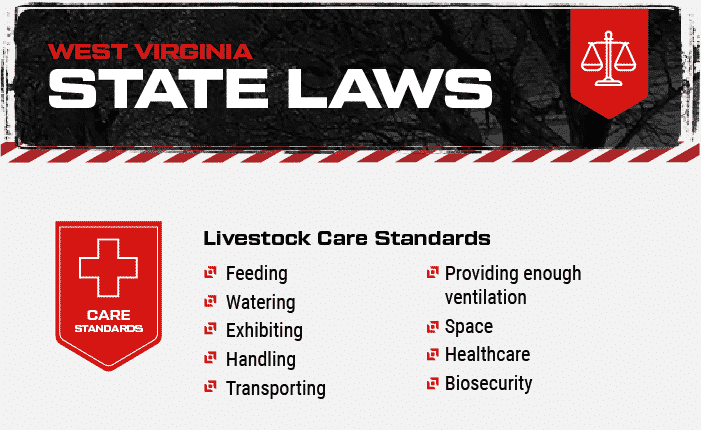
Livestock owners are also responsible for damages sustained if an animal escapes or is carelessly allowed to roam around. Any person who finds livestock running at large may impound the animal until the owner pays damages and keeping costs.
Climate
West Virginia experiences 4 seasons:
- Summer – Humid and hot temperatures
- Spring – Cooler temperatures
- Fall – Cooler temperatures
- Winter – Heavy rainfall and cold weather
The state also experiences sporadic showers and occasional thunderstorms throughout the year.
The mean annual temperature in West Virginia is 56 degrees Fahrenheit in the south to 52 degrees Fahrenheit in the north and 48 degrees Fahrenheit in most mountainous regions.
Cost of Land
According to the Land Values 2021 Summary, the average farm real estate value per acre in West Virginia is $2,770.
Cropland’s average value per acre is $3,330. Pasture value is $2,220 per acre.
Quality of Land
Thanks to the drainage over West Virginia’s rugged surface, the state has produced the most productive, fertile, and level alluvial soils on the more extensive river floodplains.
If you’re looking for the best agricultural soils in West Virginia, you will find your luck along the Ohio River on the northwestern border.
For ideal soils for pasture and orchards, go to the east for weathered limestone soils. These types of lands will help neutralize soil acidity.
But nothing beats West Virginia’s official state soil, the Monongahela silt foam. It’s a productive agricultural soil found on the river terraces on more than 100,000 acres of land in 45 counties in the state.
Water Availability
West Virginia relies heavily on groundwater resources. This water source can be found within various geological and hydrogeologic conditions across the state. And West Virginia consists of three aquifer types: alluvial deposits, carbonate areas, and abandoned mine systems.
The high-yielding alluvial deposits are typical of the Ohio River Valley that comprises the state’s northern and western border.
Karst developments in the eastern part of West Virginia also provide large groundwater yields from wells and springs.
In the southern part of West Virginia, mined areas provide significant groundwater from flooded abandoned coal mines. These mines form underground lakes.
Education
In West Virginia, parents are given one of two legal options by which they can homeschool their children:
Homeschooling by seeking school board approval
You’ll be required to teach the subjects approved by the local school board for 180 days per year. Instruction must be in a place approved by the board and equal to the school term of the county. You need to furnish attendance, instruction, and progress information when requested.
The board also determines the method of assessment you must use in your homeschool. This approach isn’t recommended, but it may be appropriate for some families.
Homeschooling by submitting a notice of intent
You can submit a notice that meets specific requirements to the school board or superintendent. This option doesn’t require asking permission to homeschool.
A child is excused from compulsory attendance as long as the notification complies with the law. Here are the requirements needed if you wanna homeschool under this option:
- The person providing the home instruction must have a high school diploma or equivalent or a post-secondary degree or certificate from a regionally accredited institution.
- File a notice of intent on or before the date you begin homeschooling with your school board or superintendent.
- You’re required to assess your child annually and maintain copies of the assessment for three years. Check this page to learn about yearly assessment options.
- You need to submit your child’s assessment results for the 3rd, 5th, 8th, and 11th grades to the county superintendent by June 30 of those years.
The Community
According to many locals, West Virginians have a strong sense of community and are sincere and humble. Even though their state pride runs deep, they’re still some of the nicest people on the planet and are very welcoming to outsiders.
2. Tennessee
If we’re talking about good growing seasons, Tennessee wins in that department.
Compared to most states who have shorter growing seasons, Tennessee has a harvesting time that lasts about 9 months out of the year.
That said, growing crops is obviously not a problem in “The Volunteer State.”
Find out why Tennessee is one of the candidates for the best places to live off the grid here:
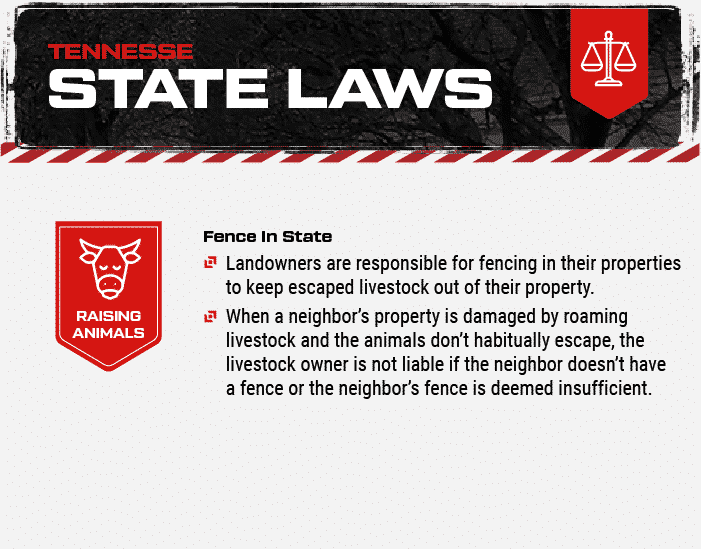
Climate
Tennessee’s climate is perfect for growing crops. It has a moderate climate with 4 distinct seasons. During the winter months, temperatures could go as low as 30 degrees Fahrenheit. In the summer, the average high temperature is 89 degrees Fahrenheit.
Cost of Land
Tennessee is every homesteader’s haven. There are 69,983 farms across 10.8 million acres of agricultural land, covering 41% of the state’s total land area.
Land in Tennessee is relatively inexpensive. As of 2021, the price of farm real estate per acre in the state is $4,260.
Water Availability
Depending on where you are in Tennessee, drinking water may come from two water sources:
- Groundwater: A water source below the ground or a spring that comes out on top of the land.
- Surface water: A water source from streams, rivers, or lakes.
Quality of Land
The state offers great expanses in the rural countryside and diverse geography, from mountains and lakes to acres of flat ground. With Tennessee’s long stretch of green land, finding a place for growing fruits and vegetables is easy.
The official state soil of Tennessee, the Dickson soil, covers 400,000 acres in 31 counties. It’s excellent for growing food, raising animals, and building stables, which means the Dickson soil is essential in producing small grains, soybeans, tobacco, pasture, and hay.
Education
Homeschooling or home education is an educational option offered to parents in Tennessee. Mothers and fathers wishing to homeschool their kids are given these 3 choices:
Independent Home School
Parents choosing this educational option should begin by contacting the local school district. The law states that independent home school students must:
- Provide annual notice to the local director of schools before each school year of the parent-teachers intent to conduct a homeschool.
- Maintain attendance records and submit these records to the Director of Schools at the end of each school year.
- Submit proof of vaccination and receipt of any health services or examinations as the law requires.
Church-related Umbrella School
Parents can also homeschool their children by registering at a church-related umbrella school. If you favor this alternative, you must provide evidence to the local school district that you enrolled your kid in a church-related school. This school will be responsible for record-keeping and providing test requirements for students under an umbrella program.
Accredited Online School
The Tennessee Department of Education also gives parents a choice to enroll their children in an online school. Going for this option means you must find a legit one—an accredited online school. You’ll be required to provide evidence to the local school district.
For additional information, check out this website.
The Community
Tennessee is full of Southern charm to fit your lifestyle. The state is famous for its country music, low cost of living, Southern comfort food, and beautiful sceneries.
It’s also a very religious and conservative state. However, folks in Tennessee are kind, extremely generous, and generally charitable. They’re also really friendly and welcoming.
1. Kentucky
Kentucky is no stranger to self-sufficiency with its strong community of thriving homesteaders, small farm owners, and off-gridders.
Growing crops in the state is easily done. Plus, there’s a high demand for farm-fresh produce.
Even better, Kentucky is considered a safe state to live in and raise a family. Here’s more info to know about the Bluegrass State:
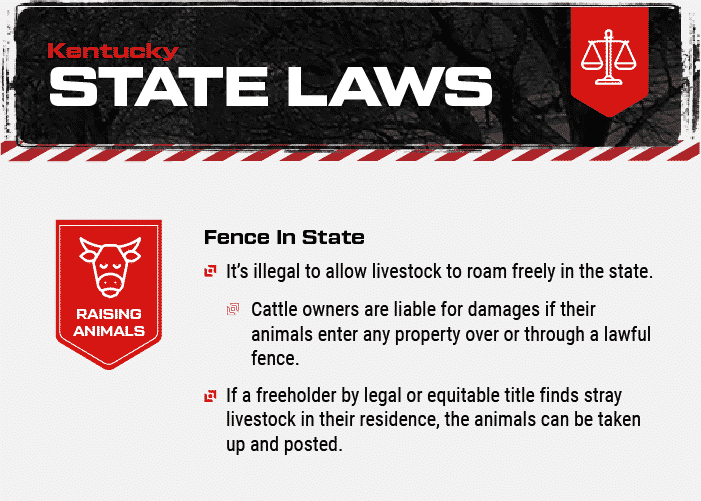
Climate
The climate in Kentucky is typically mild and moderate, and the state enjoys 4 beautiful seasons. Temperatures in Kentucky usually range from daytime summer highs of 87 degrees Fahrenheit to the winter low of 23 degrees Fahrenheit.
In general, Kentucky experiences relatively hot, humid, rainy summers and moderately cold and rainy winters.
Cost of Land
According to the 2021 Land Values Report, Kentucky’s average farm real estate value is $4,000 per acre. Cropland value is at $4,510 per acre, and pasture value is $3,080 per acre.
Quality of Land
Kentucky is home to various rich soils, but the Cider soil is considered the official state soil since it covers over 500,000 acres and 35 counties. The Cider soil is well-drained and extremely productive, best to match Kentucky’s long and warm growing seasons.
Kentucky’s top commodities include:
- Wheat
- Soybeans
- Corn
- Hay
Water Availability
Kentuckians consume 4.3 billion gallons of water yearly. They use 95 percent of surface water (rivers, lakes, streams, ponds, and wetlands) and 5 percent of groundwater (pore spaces within rocks and alluvium, in fractures, and solution openings). These sources of water are present throughout Kentucky’s 39,486 square miles.
According to the Kentucky Geological Survey, 815 public supply systems provide water for 80 percent of the population.
Education
The Kentucky Constitution establishes that parents may choose the formal education of their children. Parents who choose to homeschool are required to:
- Notify the superintendent of the local school board in writing within ten days of the beginning of the school year of their intent to homeschool their child(ren) each year they homeschool.
- Establish a bona fide school for the children to attend.
- All kids must be enrolled in school between the ages of 6 and 18.
- Record and maintain scholarship reports of each student’s progress in all subjects taught at the same intervals as the local public schools.
- Keep accurate attendance records of pupil attendance.
- Subjects taught should include reading, writing, spelling, grammar, history, mathematics, science, and civics.
- Offer all the core instruction in the English language.
The Community
Kentucky is the perfect state for living off the grid if you’re looking for affordable home prices, a low cost of living, and top-tier natural and state parks.
Things like healthcare, food, and transportation are cheaper in Kentucky compared to other states. And, of course, the southern friendliness of Kentuckians seals the deal. They’re genuinely and selflessly kind and helpful to everyone.
Bonus: The Worst States for Off Grid Living
If there are states that seem to be built specifically for living off the grid, there are also states that simply aren’t meant for the lifestyle.
Check out the 3 worst places for off grid living here:
1. Arizona
No disrespect to Arizona, but it’s just not a good place for living off the grid. Sure, the land is cheap. But how’s that gonna help when you’ll have a hard time harvesting vegetables with its desert climate?
As if that wasn’t enough of a problem, the state also has strict laws on raising livestock, selling certain types of food, and using water. You’ll need a permit to use any surface water, even if it’s on your property.
Hauling off-the-grid water will also be expensive. You won’t only be paying a lot for the water; you’ll have to cough up money for gas, too. Not to mention how much time that will take.
2. Nevada
Think you can disconnect from the grid right away? Not in Nevada. You need to secure the correct permits before living off the grid in this state.
Another reason Nevada made it on the list of worst states for off grid living is that its property cost is higher than the national average. To add, its expensive cost of living might also deter folks from making the move.
When talking about growing produce, Nevada isn’t the ideal environment, too. The majority of its towns are located in desert areas, meaning your vegetables won’t stand a chance under such a harsh climate.
If that doesn’t make you scratch Nevada off your list, maybe its scarce groundwater will. Plus, collecting rainwater in the state will be a headache with its many restrictions and strict guidelines.
3. Hawaii
At first, Hawaii seems like the best state to live off grid. Its stunning expansive landscapes will probably convince you to buy a property to grow food and raise livestock. However, land in Hawaii will cost you an arm and a leg. Property cost in the Land of Aloha is one of the highest prices in the country.
Living expenses will also cost you because supplies, materials, and other necessities need to be shipped by air or sea. As a result, there’s a markup on many general goods. For example, a loaf of bread or a sack of potatoes will be pricey.
If the cost of land and living doesn’t make you worry, then an active volcano might. This is a huge safety risk, especially if you’re moving with family. Who knows when volcanoes can erupt, right?
Final Thoughts
There you go! That’s the scoop on the best places to live off the grid. Any of these will be a great place to settle down and live out your dream of being self-reliant.
Just remember that this is a general list of the best states for off grid living. At the end of the day, it all boils down to your personal preferences. What may seem like an ideal climate or community for others may not be the same for you.
We hope you found this off grid living guide helpful. Let us know if there’s anything we missed out on!



